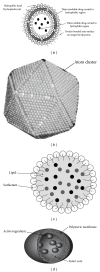Nanotechnology-based cosmeceuticals
- PMID: 24963412
- PMCID: PMC4055113
- DOI: 10.1155/2014/843687
Nanotechnology-based cosmeceuticals
Abstract
Cosmeceuticals are the fastest growing segment of the personal care industry, and a number of topical cosmeceutical treatments for conditions such as photoaging, hyperpigmentation, wrinkles, and hair damage have come into widespread use. In the cosmeceutical arena nanotechnology has played an important role. Using new techniques to manipulate matter at an atomic or molecular level, they have been at the root of numerous innovations, opening up new perspectives for the future of cosmeceutical industry. Nanotechnology-based cosmeceuticals offer the advantage of diversity in products, and increased bioavailability of active ingredients and increase the aesthetic appeal of cosmeceutical products with prolonged effects. However increased use of nanotechnology in cosmeceuticals has raised concern about the possible penetration of nanoparticles through the skin and potential hazards to the human health. This review outlines the different nanoparticles used in various classes of cosmeceuticals, nanotechnology-based cosmeceutical products present in the market, and the potential risk caused by nanoparticles on exposure and recent regulatory steps taken to overcome them.
Figures





References
-
- U.S. Food and Drug Administration. Is it a cosmetic, a drug, or both? (Or is it soap?) http://www.fda.gov/cosmetics/guidancecomplianceregulatoryinformation/ucm.... - PubMed
-
- U.S. Food and Drug Administration. Cosmetics Q&A: FDA’s Authority. http://www.fda.gov/Cosmetics/ResourcesForYou/Consumers/CosmeticsQA/ucm13....
-
- Fulekar MH. Nanotechnology: Importance and Application. New Delhi, India: IK International Publishing House; 2010.
-
- Mukta S, Adam F. Cosmeceuticals in day-to-day clinical practice. Journal of Drugs in Dermatology. 2010;9(5):s62–s66. - PubMed
-
- Cosmeceuticals: Products and Global Markets. http://www.bccresearch.com/market-research/advanced-materials/cosmeceuti....
Publication types
LinkOut - more resources
Full Text Sources
Other Literature Sources

